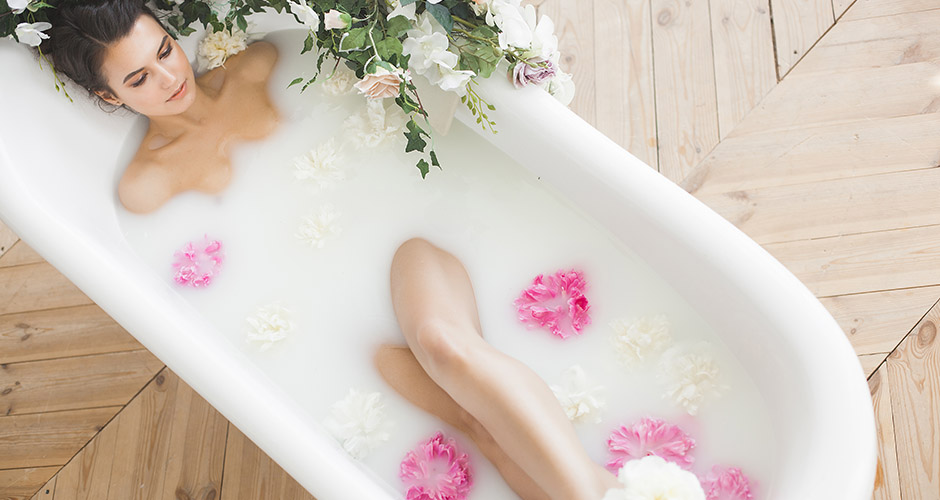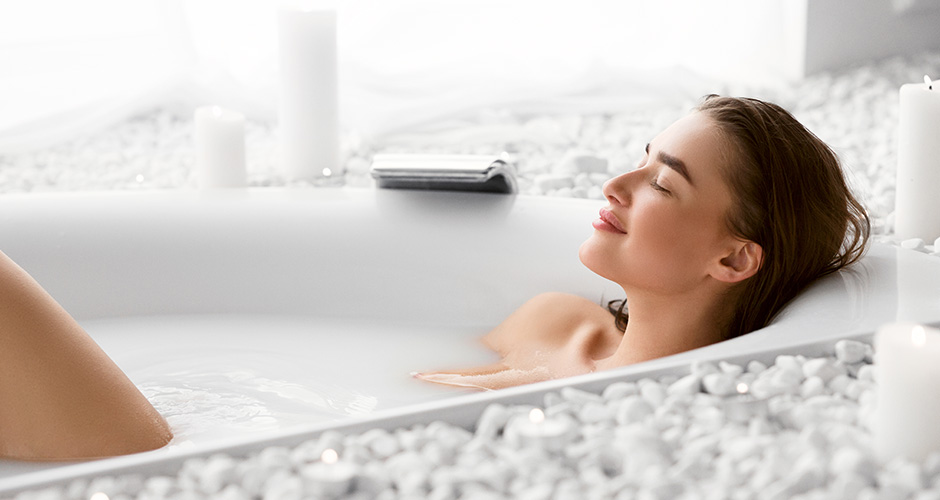While most of us are used to bathing at least once a day, baths were once an indulgence people only enjoyed a few times a year. It was only the wealthy who had the luxury of bathing frequently. Some took the luxury to the next level, bathing in milk rather than water. Cleopatra was known for bathing in honeyed milk on a daily basis.
The idea of bathing in milk may sound a little strange, but it could be the secret to healthy skin. Here’s what you need to know about the potential benefits of milk baths along with why and how you should incorporate them into your skincare routine.
What is a Milk Bath, Anyway?
The term milk bath is self-explanatory – it’s a bath made with milk. Rather than filling an entire bathtub with milk, however, you add milk to warm bath water. Milk baths can be made with either liquid or powdered milk and it doesn’t have to be limited to cow’s milk. Different milks like goat milk, coconut milk, and rice milk offer unique skin-boosting benefits.
The Benefits of Bathing for Skin, Mind, and Body
Nothing feels better at the end of a stressful day than relaxing in a warm bath. There’s a reason a hot bath is a popular form of self-care! But the benefits of bathing go well beyond simply providing an opportunity to relax and unwind.
Here are some of the benefits of bathing:
- Being immersed in water above chest level warms the heart and lungs. As the heart beats faster, it pumps more oxygenated blood through your body. The pressure of the water on your chest may help improve lung capacity and oxygen intake.
- Bathing may help reduce pain and inflammation. Hydrotherapy has been recognized as an effective treatment for painful conditions like multiple sclerosis (MS), shown to gently relieve spinal discomfort with the pressure of the water.
- Moving and stretching in water is a low-impact way to improve strength and joint flexibility. It provides gentle resistance and helps take some of the weight off your joints.
- Breathing in the warm steam from a bath can boost respiratory health as well as immunity. A hot bath can help kill bacteria and breathing the steam may relieve symptoms of cold and flu.
- Cold baths may offer some hormone-balancing benefits which could be helpful for chronic fatigue syndrome and some fertility issues. Warm baths can boost serotonin levels.
- Bathing helps moisturizer the hair, skin, and eyes. While soaking in warm water and taking in the steam is great, bathing in water that’s too hot could have the opposite effect and dry out your skin.
- Taking a bath is a great stress reliever and may help you sleep better at night. Scientists recommend sleeping in a cool room to improve sleep but taking a warm bath before bed can have the same effect in lowering your body temperature (even though it may seem counterintuitive).
Outside of the skin, mind, and body benefits of bathing remains the obvious – it keeps you clean. A shower is a quick and efficient way to bathe, but there’s something to be said for the occasional hour spent soaking in a hot tub. Even better if you add a little milk or milk boosted with aromatic essential oils to the water!
Should You Incorporate Milk Baths into Your Routine?

Milk has long been used as a folk remedy for skin concerns like eczema, psoriasis, sunburn, and other forms of skin irritation. There’s currently little scientific research that milk baths help with these problems, but anecdotal evidence suggests milk baths may help make the skin softer and smoother. Milk baths also deliver gentle exfoliation – especially soured milk which contains lactic acid, a skincare ingredient you’ll often see that’s included to help reduce the appearance of fine lines.
While milk baths may be less effective than targeted skincare products, can be a great addition to any skincare routine. They’re also easy to prepare at home.
When preparing a milk bath at home, put some thought into the ingredients you choose. Full-fat milk is ideal for milk baths because it contains more of the healthy fats and nutrients your skin needs. To turn your milk bath into a luxurious self-care ritual, mix in a few drops of high-quality essential oil. Certain essential oils promote relaxation while others intensify microcirculation to boost the body’s self-cleansing mechanisms.
Here’s how to prepare a milk bath at home:
- Fill the tub with warm water – don’t make it too hot.
- Sprinkle in 2 cups of powdered whole milk and ½ cup of baking soda.
- Add 10 drops of high-quality essential oils (try lavender for relaxation).
- Stir with your hands or feet for at least 30 seconds until well combined.
- Soak for at least 15 minutes then gently towel dry before completing your skincare routine.
While it may not be practical to take a milk bath every day, incorporating occasional milk baths into your routine can work wonders for the mind and body. The relaxation benefits of a warm bath combined with the skin-soothing benefits of warm milk are just what you need for a self-care day.

